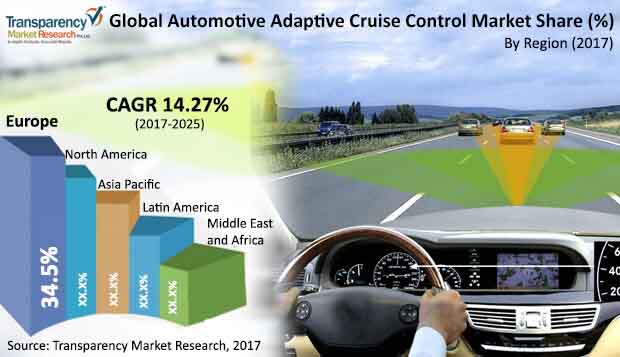Automotive Adaptive Cruise Control Market is expected to be worth US$22.1 bn in 2025
Global Automotive Adaptive Cruise Control Market: Overview
Adaptive cruise control system is a sensor based system that aids in averting front side collisions and provide comfort on a long route by allowing the driver to free his hands from steering and foot from accelerating pedal. Adaptive cruise control system allows vehicle to drive at a preset constant speed as well as it stops the vehicle at a preset distance from the vehicle in front. This system is helpful in traffic conditions as it accelerates and stops the vehicle. Adaptive cruise control system provides relief to the driver in traffic as well as on a long route as the driver don’t have to maintain the speed by continuously pressing the pedal and brakes. According to Transparency Market Research, the global automotive adaptive cruise control market is expected to be worth US$22.1 bn in 2025 from US$ 6.60 bn in 2016. During the forecast years of 2017 to 2025, the global market is expected to exhibit a CAGR of 14.27%.
To Garner Compelling Insights on The Forecast Analysis of Market, Request a Sample Here

Long Range Detection of RADAR Sensors to make them Popular Amongst Automotive Adaptive Cruise Controls
The automotive adaptive cruise control market has been segmented into four categories, namely, technology, mode of operation, vehicle, and region. In terms of technology, the adaptive cruise control system market can be segmented into RADAR and LIDAR. In terms of revenue, RADAR sensors hold about 82% share of adaptive cruise control market, followed by LIDAR sensors. The demand for RADAR sensors is expected to remain high in the near future as they offer better efficiency in worst of weather conditions. Furthermore, their longer range of detection makes them a much suitable option than LIDA sensors. Thus, the growing number of vehicular mishaps are expected to keep the demand for RADAR sensors on the rise in the forthcoming years.
In terms of mode of operation, adaptive cruise control system market has been segmented as normal adaptive cruise control system and connected adaptive cruise control system. In terms of revenue the normal adaptive cruise control system market holds more than 97% of adaptive cruise control system market. However, the increasing sales of autonomous vehicles is likely to boost the demand for connected adaptive cruise control systems during the forecast period.
In terms of vehicle, the automotive adaptive cruise control market has been classified into passenger vehicle and commercial vehicle. In terms of revenue, passenger vehicles held the largest share in 2016, owing to the increase in demand for passenger cars in the automotive industry.
For More Actionable Insights into The Competitive Landscape of Market, Get a Customized Report Here
Awareness for Human Safety in North America Helps Regional Market to Dominate
In terms of region, the Adaptive Cruise Control market has been classified into North America, Europe, Asia Pacific, Middle East & Africa, and Latin America. In 2016, North America dominated the adaptive cruise control market with 38.41% share. Greater importance toward human safety is expected to be ht key driver for the growth of this regional segment. The consistent investment in research and development in the automotive sector of Europe and North America is also anticipated to play a critical role in defining the progress of these regional markets. Asia Pacific and Middle East and Africa are anticipated to dominate the market in the forecast period.
Key players in the automotive Adaptive Cruise Control market are expected to benefit from the formation of strategic alliances with global players in the automotive Adaptive Cruise Control market. Prominent players in the automotive Adaptive Cruise Control market are Robert Bosch GmbH, Continental AG, ZF Friedrichshafen AG, Denso Corporation, Delphi Automotive LLP, Preco Electronics, Autoliv Inc., Valeo, Magna International, WABCO, Hitachi Ltd., and Mando Corp.

